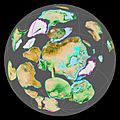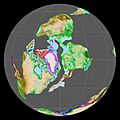Laurussia facts for kids
Laurussia was an ancient landmass, a bit like a smaller supercontinent, that came together during the Devonian Period. You might also hear it called the Old Red Sandstone Continent or Euramerica.
Laurussia included large parts of what we now know as northern Europe, Greenland, and North America.
How Laurussia Formed
Laurussia was created when three smaller continents crashed into each other. These continents were called Baltica, North America, and Avalonia. This big collision happened during the Silurian Period.
First, Baltica and Avalonia joined together. This was part of a huge mountain-building event called the Caledonian orogeny. After that, Avalonia and Baltica (now joined) then collided with North America. This second collision was also part of the Caledonian orogeny.
As Avalonia moved and crashed, it caused the ancient Iapetus Ocean to close up. At the same time, a new ocean, called the Rheic Ocean, began to open up behind it.
Laurussia's Journey Through Time
Laurussia didn't stay a separate landmass forever. In the Permian Period, it became a part of an even bigger supercontinent called Pangaea. Imagine all the major landmasses of Earth joined into one giant continent!
Later, during the Jurassic Period, Pangaea started to break apart. It split into two large supercontinents: Gondwana and Laurasia. Laurussia became a part of Laurasia.
Finally, the Atlantic Ocean began to open right in the middle of Laurussia. This caused Laurussia to split into the continents we recognize today: North America and Europe.
Images for kids





